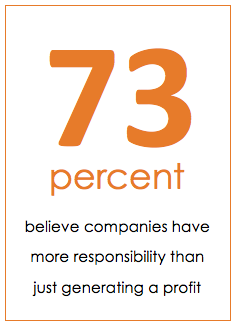Like what you see?
3 Ways to Create a Winning Sustainability Report
 Last year, a study by Havas Worldwide reported that 73 percent of people surveyed believe companies have more responsibility than just generating a profit. When it comes to corporate social responsibility (CSR), brand authenticity sets a company apart. This demand for authenticity has caused established CSR reporters to rethink their efforts—and has prompted more organizations to undertake reporting for the first time.
Last year, a study by Havas Worldwide reported that 73 percent of people surveyed believe companies have more responsibility than just generating a profit. When it comes to corporate social responsibility (CSR), brand authenticity sets a company apart. This demand for authenticity has caused established CSR reporters to rethink their efforts—and has prompted more organizations to undertake reporting for the first time.
Ameren Corporation is a good example. The Midwest energy provider published its first-ever CSR report in 2011. In the short time since, the utility has become an industry leader in reporting (with Simantel’s help). In fact, the company’s 2016 edition just won a slew of honors from the League of American Communication Professionals’ Vision Awards, including Best Narrative in the Americas Region and ranking among the world’s Top 20 reports.
So how can your company or organization enhance your own citizenship, sustainability, CSR, integrated, community impact or environmental reporting effort?
Behold: Here are some tips.
 Accepted constructs like People, Planet, Profit (the Three P’s) are a good place to start when seeking to organize the metrics to report and the stories to share. Broadly, consider how your activities…
Accepted constructs like People, Planet, Profit (the Three P’s) are a good place to start when seeking to organize the metrics to report and the stories to share. Broadly, consider how your activities…
- Help to sustain people — The customers you serve, the communities you care about and the workforce and suppliers you rely upon to succeed
- Affect, for better or worse, the planet you live on— We’re assuming it’s Earth;
- Influence your ability to raise money or otherwise sustain your organization’s long-term financial health — Ask yourself why it matters to key stakeholders whether you remain a viable entity. How does success or failure impact them?
The Three P’s are just a starting point. Don’t stop there. Strive to articulate, as does Ameren, how sustainability uniquely relates to your mission and business strategy. The structure of your report can flow from there, rather than trying to divvy it up using pre-defined “buckets.” It’s cool to get creative.
 No matter what format your reporting takes–a website, a blog, a PDF, or a combination of these–it should not be an exhaustive retelling of every action you’ve taken that relates to sustainability. This is a highlight reel. Time to winnow your content.
No matter what format your reporting takes–a website, a blog, a PDF, or a combination of these–it should not be an exhaustive retelling of every action you’ve taken that relates to sustainability. This is a highlight reel. Time to winnow your content.
To do that, consider “materiality.” As defined in great detail by the independent Global Reporting Initiative, material issues worthy of reporting include the current and future risks and challenges your sector faces. What do you customers care about? Your employees? What burning legal or regulatory issues do you face? If you’re an investor-owned company, what expectations do your shareholders have? What societal issues are you focused on?
For Ameren’s 2016 report, Simantel helped the company create vignettes and report on priorities relevant to the energy industry as a whole, from rates and reliability to safety and environmental impacts.
 Self-evaluation is hard. Especially for smaller organizations that lack an audit function to set/track objective sustainability KPIs. That doesn’t mean you can’t step back and scrutinize your own performance. Ask and evaluate…
Self-evaluation is hard. Especially for smaller organizations that lack an audit function to set/track objective sustainability KPIs. That doesn’t mean you can’t step back and scrutinize your own performance. Ask and evaluate…
- Where are you succeeding in the material areas relevant to your stakeholders?
- What can you do better? Seriously. Not just kind of, but for reals.
- What do you want to achieve but haven’t yet? Tell us what, why and when.
Sincerity and authenticity are the foundation of trust. Consider especially that younger folks–who’ve been living their lives wide open on social media–demand “realness” in the places they work and from the brands they buy.
We have a lot more tips to share, connect with us if you’d like to discuss how to elevate your reporting efforts.



